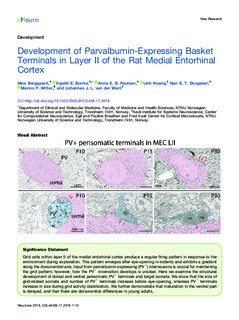| dc.contributor.author | Berggaard, Nina | |
| dc.contributor.author | Bjerke, Ingvild Elise | |
| dc.contributor.author | Paulsen, Anna Elisabeth Bråthen | |
| dc.contributor.author | Hoang, Linh | |
| dc.contributor.author | Skogaker, Nan Elisabeth Tostrup | |
| dc.contributor.author | Witter, Menno | |
| dc.contributor.author | Van der Want, Johannes | |
| dc.date.accessioned | 2018-07-11T06:57:51Z | |
| dc.date.available | 2018-07-11T06:57:51Z | |
| dc.date.created | 2018-06-15T11:16:53Z | |
| dc.date.issued | 2018 | |
| dc.identifier.issn | 2373-2822 | |
| dc.identifier.uri | http://hdl.handle.net/11250/2505085 | |
| dc.description.abstract | Grid cells in layer II of the medial entorhinal cortex (MEC LII) generate multiple regular firing fields in response to the position and speed of an individual within the environment. They exhibit a protracted postnatal development and, in the adult, show activity differences along the dorsoventral axis (DVA). Evidence suggests parvalbumin-positive (PV+) interneurons, most of which are perisomatic-targeting cells, play a crucial role in generation of the hexagonal grid cell activity pattern. We therefore hypothesized that the development and organization of PV+ perisomatic terminals in MEC LII reflect the postnatal emergence of the hexagonal firing pattern and dorsoventral differences seen in grid cell activity. We used immuno-electron microscopy to examine the development of PV+ perisomatic terminals and their target somata within dorsal and ventral MEC LII in rats of postnatal day (P)10, P15, and P30. We demonstrate that in dorsal and ventral MEC LII, the cross-sectional area of somata and number and density of perisomatic PV+ terminals increase between P10 and P15. A simultaneous decrease was observed in cross-sectional area of PV+ terminals. Between P15 and P30, both MEC regions showed an increase in PV+ terminal size and percentage of PV+ terminals containing mitochondria, which may enable grid cell activity to emerge and stabilize. We also report that dorsal somata are larger and apposed by more PV+ terminals than ventral somata at all stages, suggesting a protracted maturation in the ventral portion and a possible gradient in soma size and PV+ basket innervation along the DVA in the adult. | nb_NO |
| dc.language.iso | eng | nb_NO |
| dc.publisher | Society for Neuroscience | nb_NO |
| dc.rights | Navngivelse 4.0 Internasjonal | * |
| dc.rights.uri | http://creativecommons.org/licenses/by/4.0/deed.no | * |
| dc.title | Development of Parvalbumin-Expressing Basket Terminals in Layer II of the Rat Medial Entorhinal Cortex | nb_NO |
| dc.type | Journal article | nb_NO |
| dc.type | Peer reviewed | nb_NO |
| dc.description.version | publishedVersion | nb_NO |
| dc.source.journal | eNeuro | nb_NO |
| dc.identifier.doi | https://doi.org/10.1523/ENEURO.0438-17.2018 | |
| dc.identifier.cristin | 1591442 | |
| dc.description.localcode | Copyright © 2018 Berggaard et al. This is an open-access article distributed under the terms of the Creative Commons Attribution 4.0 International license, which permits unrestricted use, distribution and reproduction in any medium provided that the original work is properly attributed. | nb_NO |
| cristin.unitcode | 194,65,15,0 | |
| cristin.unitname | Institutt for klinisk og molekylær medisin | |
| cristin.ispublished | false | |
| cristin.fulltext | original | |
| cristin.qualitycode | 1 | |

